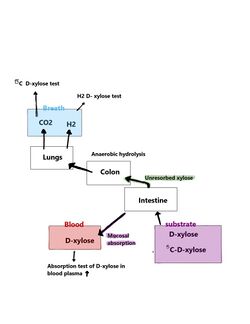Carbon-13 labeled D-xylose breath test
D-xylose is 5-carbon monosacharide (pentose). About 60% is passively absorbed in the proximal part of the small intestine (duodenojejunal) and is eliminated from the circulation by the kidneys. Clearance cca 87 % is due to the tubular resorption of D-xylose. In the classic stress test with D-xylose, 5-25 g of D-xylose is administred orally. In the laboratory is determined the level in serum and urine in the fasted state and 5 hours after the application of the load (a 5-hour urine collection is performed to determine urine waste). A breath test with oral xylose exists as H2-xylose test, with administration of labeled xylose such as 14C-xylose or 13C-xylose test. Xylose is further metabolized by bacteria in the small and large intestine, so the decrease in absorption, determined mainly by the classical tolerance test, is diagnostically significant for malabsorption, while increased metabolism of xylose is detectable by bacterial overgrowth in the small intestine. The indication for the xylose breath test is therefore mainly syndrome of bacterial overgrowth, blind loops syndrome, etc. The dose of xylose administered varies from 10 mg to 10 g (depending on the test design).
'Performing a test' in our lab is as follows. The patient takes an exhaled air sample on an empty stomach, drinks a 200 ml solution of 100 mg of C-xylose, and one exhaled air sample is taken every 60 minutes for the next 6 hours. The evaluation is kinetic, we evaluate the maximum achieved ratio 13 CO 2 : 12 CO 2 , the time shift of the maximum, and the total the amount of metabolized 13 C-xylose by the so-called cumulative release in 6 hours.
References[edit | edit source]
Related articles[edit | edit source]
Source[edit | edit source]
- with permission of the author taken from KOCNA, Petr. GastroLab : MiniEncyklopedie laboratorních metod v gastroenterologii [online]. ©2002. The last revision 2011-01-08, [cit. 2011-03-04]. <http://www1.lf1.cuni.cz/~kocna/glab/glency1.htm>.
Used literature[edit | edit source]
- TVEITO, K. , et al. 13C-xylose and 14C-xylose breath tests for the diagnosis of coeliac disease. Scand J Gastroenterol [online]. 2008, vol. 43, no. 2, p. 166-73, Available from <http://www.tandfonline.com/doi/abs/10.1080/00365520701659118?cookieSet=1>. ISSN 0036-5521. DOI: 10.1080/00365520701659118.
- RANA, SV. , et al. Comparison of D-xylose hydrogen breath test with urinary D-xylose test in Indian children with celiac disease. Digestive Diseases and Sciences. 2007, vol. 52, no. 3, p. 681-4, ISSN 1573-2568 (online). PMID: 17237998.
- WALTERS, B – VANNER, SJ. Detection of bacterial overgrowth in IBS using the lactulose H2 breath test: comparison with 14C-D-xylose and healthy controls. Am J Gastroenterol. 2005, vol. 100, no. 7, p. 1566-70, ISSN 1572-0241 (online). PMID: 15984983.
- WIGG, AJ. , et al. The role of small intestinal bacterial overgrowth, intestinal permeability, endotoxaemia, and tumour necrosis factor alpha in the pathogenesis of non-alcoholic steatohepatitis. Gut. 2001, vol. 48, no. 2, p. 206-11, ISSN 1468-3288 (online). PMID: 11156641.
- STOTZER, PO. , et al. Comparison of the 1-gram (14)C-D-xylose breath test and the 50-gram hydrogen glucose breath test for diagnosis of small intestinal bacterial overgrowth. Digestion. 2000, vol. 61, no. 3, p. 165-71, ISSN 1421-9867 (online). PMID: 10773721.
- DELLERT, SF. , et al. The 13C-xylose breath test for the diagnosis of small bowel bacterial overgrowth in children. Journal of pediatric gastroenterology and nutrition. 1997, vol. 25, no. 2, p. 153-8, ISSN 1536-4801 (online). PMID: 9252901.
- LEWIS, SJ. , et al. Improvement in specificity of [14C]d-xylose breath test for bacterial overgrowth. Digestive diseases and sciences. 1997, vol. 42, no. 8, p. 1587-92, ISSN 1573-2568 (online). PMID: 9286221.
- CHANG, CS. , et al. Increased accuracy of the carbon-14 D-xylose breath test in detecting small-intestinal bacterial overgrowth by correction with the gastric emptying rate. European journal of nuclear medicine. 1995, vol. 22, no. 10, p. 1118-22, ISSN 0340-6997. PMID: 8542894.

